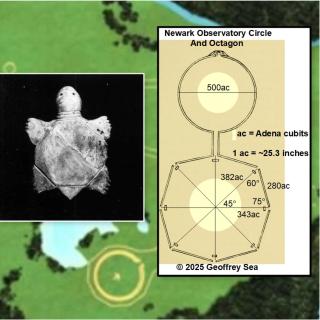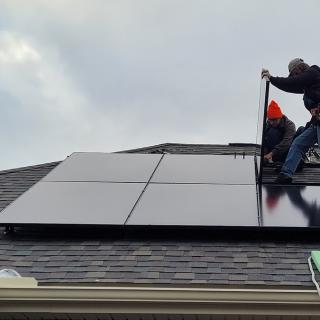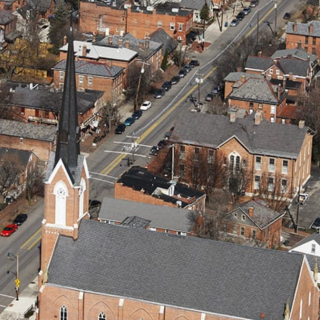Last night at 5:49 p.m., the Antrim, Ohio, volunteer fire department chief posted the first of four videos on its Facebook page of a raging fire at a well pad just off State Route 22.
The location is a 5.7 miles – a seven-minute drive along SR 22 – from the entrance to Salt Fork State Park.
Information soon emerged that the fire was caused by an explosion at the Groh well pad (GIS coordinates 40.110854 N, 81.370555 W), owned by Gulfport Appalachia. Drone footage found one tank had completely collapsed with a second tank breached, the fire chief said.
As flames shot 100 feet into the air, authorities in consultation with Gulfport decided to let the fire burn itself out. SR 22 was closed and would remain closed for several hours.
No one was injured, but an evacuation was called for everyone in a half-mile radius. Residents near Fairground Road, Brushy Fork Road, Dutch Barn Builders, and Rainbow Road were asked to leave their homes and go to the fire station for assistance.
“If you are getting the fumes and smoke, please leave your home and go to the firehouse. We’ll get you documented. If you’re having difficulties with breathing … we have an EMS crew waiting,” the chief said in the fourth video. “There is nothing we can do safely to put the fire out.”
Gulfport involved in $3.7 million EPA settlement
Of all the oil and gas companies seeking to frack Ohio’s public land, Gulfport has perhaps the worst track record. In January 2020, the US Environmental Protection Agency announced a $3.7 million settlement with Gulfport over pollution from its oil and gas operations in Ohio.
The consent decree included $1.7 million in penalties for emissions of 313 tons per year of volatile organic compounds (VOCs), as well as a required $2 million investment to improve 17 well pads in Eastern Ohio.
The Groh well pad was one of the 17 subject facilities listed in the EPA-Gulfport consent decree (see Appendix D, p. 103).
The Groh well pad was listed in Category 2B, requiring Gulfport to implement a program to reduce emissions, including
- Adhering to performance standards;
- Using a directed inspection program and preventive maintenance program;
- Assessing and implementing an investigation and corrective action;
- Performing tank pressure monitoring.
Gulfport was required to put this program into effect in January 2020. Now in January 2025, one of the tanks on this same well pad has exploded, with a second tank breached, requiring evacuation of homes in a half-mile radius.
ODNR practicing due diligence? One must wonder
Who was checking up on whether Gulfport Appalachia followed the orders in the EPA consent decree? If Gulfport had inspected the tanks on the well pad, done preventive maintenance, implemented corrective action, and monitored tank pressure, would this explosion have happened?
We are immensely lucky that no one was at the well pad when this explosion took place. We are also lucky this did not occur on one of the many well pads within a few hundred feet of Salt Fork State Park or other public lands; otherwise, the outcome would have been very different.
Gulfport awarded seven bids to frack public land
Yet despite Gulfport’s track record in Ohio, the Oil and Gas Land Management Commission has seen fit to award seven bids for oil and gas extraction from public lands to Gulfport Appalachia – more than any other oil and gas company seeking to frack public lands.
These bids include:
- 23-DOT-0004 - 9.3 acres along SR 800 and SR 148 in Belmont County
- 23-DOT-0005 - 120.5 acres along SR 7 in Belmont County
- 24-DOT-0002 - 3.1 acres along SR 331 in Belmont County
- 24-DOT-0003 - 1.3 acres along SR 78 in Monroe County
- 24-DOT-0004 - 2.8 acres along SR 26 in Belmont County
- 24-DOT-0011 - 4.7 acres along SR 800 in Monroe County
- 24-DNR-0003 - 30.3 acres in Egypt Valley Wildlife Area in Belmont County
Even worse, the bid paperwork for all seven bids awarded to Gulfport Appalachia show lapsed insurance in 2023 or before. None of the seven bids shows current insurance.
One must wonder, with disasters like this on a Gulfport well pad, does it have current insurance? What if this explosion had occurred at one of the seven public lands they have been approved to frack? Who will bear the cost of cleaning up after this explosion?
Gulfport involved in years of accidents and incidents
Nor is this incident the first among Gulfport’s operations in Ohio. Other Gulfport incidents over the years unearthed by the Daily Accident Report through public records requests of the Ohio Department of Natural Resources include:
In 2013, Gulfport was fined $250,000 by the Ohio Department of Natural Resources for ground contamination at seven wells in Belmont and Harrison Counties
- In 2016, a truck carrying radioactive frack waste overturned, releasing 5000 gallons into a stream leading to the city of Barnesville’s drinking water reservoir in Belmont County, causing it to be taken offline for three months
- In 2019, an unknown amount of drilling brine waste was released from the Luyster well pad in Harrison County. Elevated levels of radium were found in the groundwater and surface water.
- In 2021, Rice Drilling and Gulfport Energy were court ordered to pay over $40 million to a landowner in Belmont County for drilling beyond the agreed upon lease, possibly the largest jury verdict in county history.
- In 2021, Gulfport found breaches in the containment liner of a production tank at the Wagner well pad in Harrison County, with an estimated 80 barrels (3360 gallons) of condensate released into the soil.
- In 2022, a loss of well control at Gulfport’s Charlotte well in Belmont County resulted in a brine spill and land contamination
We’ve said it before and we’ll say it again: The risks of fracking our beloved Ohio state parks, wildlife areas, and public lands are not worth the short-term profits to the oil and gas industry or the state of Ohio.
Oil and gas operations in Ohio have experienced 1,400 incidents over the past five years – one every 1.5 days – including fires, explosions, gas releases, loss of well control, transportation accidents, and more, according to an analysis by FracTracker Alliance.
It is not a matter of if, but when, a disaster will strike fracking operations near an Ohio state park, wildlife area, or other public land.
Ohio must stop selling off its most precious public lands for oil and gas extraction, and transition quickly to sustainable and renewable energy. Any other choice sells out the future of our state and everyone who lives here.



